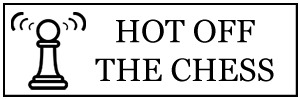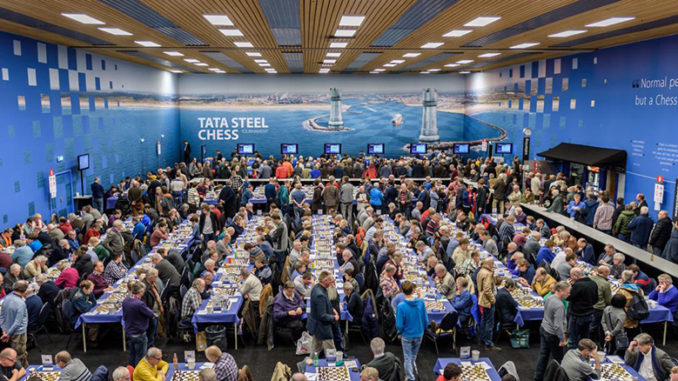
Round 4 of the Tata Steel Chess Tournament 2017, on January 17th, would be the final round before the first rest day. One never really knows what to expect in such instances, it is possible that the players will make extra effort to score due to having a day off the day after — but it is equally possible that they will take it easy, wanting to maximise their rest opportunity and come out fresh for the following round. All eyes descended on Wijk aan Zee to see what fortunes would bring.
And the round would not disappoint — there were a couple of quiet draws, but we saw points scored also. World Champion, Magnus Carlsen scored his second point of the tournament, with a win over Yi Wei. Carlsen set out his stall immediately in the game, playing 1.e4 and 2.Bc4 in order to avoid his opponent’s Petroff Defence. Magnus clearly wanted to play. His 15.Bxg5 seems to be a novelty, and after 15…Bxg5 16.d4, he was getting the kind of position that he enjoys.
When the Queens came off the board, White had the advantage (though ever so slight), with more space on the Kingside. The question was whether Magnus could make it count and carry out one of his famous squeezes. In the end, he actually didn’t need to, his opponent erred with 28…Ne4(?). The problem with the move, was that it placed the knight in a very precarious position and, after Carlsen’s 29.b4!, without safe squares to retreat to. Black had problems.
And these problems very quickly worsened. There followed, 29…g5 30.c4 c5(?) relinquishing support of d5. 31.Nb5 brushed away the threat to Carlsen’s own knight and he was threatening to simply capture cxd5 and win a a piece. There was little that Black could do against this and after 31…gxf4 32.Kxf4, reality bit and Wei resigned.
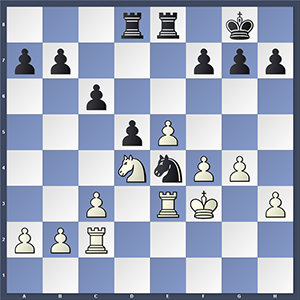
Dutch Grandmaster, Loek van Wely is not having the best of times in Wijk aan Zee and in this round his fortunes were not to improve. He faced Wesley So, who must be feeling that the chess gods are with him after his lucky escape against Richard Rapport in the previous round. Playing White, van Wely chose the English opening, obtaining the bishop pair and a nice solid position. Less ideal were double b-pawns, but Black was not in a position to get at these immediately. So equalised no problem, and some slow play by van Wely allowed Black to make good progress, posting a good knight on e4 and lining his rooks up along the a-file, ready to push where White was weakest.
24.d5(?) was an ill-advised choice by Loek, who after Wesley’s 24…c5 had done nothing but inflict an isolated pawn upon himself. Black mobilised against White’s weaknesses very quickly, the doubled b-pawns coming under fire and Loek decided to ditch them in order to push his d-pawn. And he didn’t do too badly from this, until 31.b3(?) which allowed So to mobilise his Queenside pawn majority, which started to advance like there was no tomorrow. White’s position deteriorated very speedily from here and it was all a bit of a rout in the end, with Black on the verge of Queening. Van Wely threw everything he could at his opponent, but was resigning very swiftly.
The other win of the round came from Pavel Eljanov, who defeated Baskaran Adhiban with the Black pieces. The opening was a Queen’s Indian Defence. After Adhiban’s capturing of a pawn with 8.dxc5, Eljanov’s novelty of 8…Be7 delayed recapturing in order to focus on development. Previously the pawn had been regained immediately with 8…Bxc5 but then White’s usual follow up is to develop his bishop to g5, with tempo on the Black Queen. Eljanov’s move stops that and forces White to come up with something else at the same time as being a good developing move anyway. This is illustrated by Adhiban’s 9.Bd2, which transposes to a position that has been seen a few times before.
White got the better of things out of the opening, with a nicely placed knight on e5 and his bishops sweeping across from the Queenside towards Black’s King. When the Queen’s came off, the endgame was quite equal, White had an extra pawn, but doubled pawns on the h-file. By contrast, Black’s pawns looked nice, and among these was an advanced passer on the a-file. Unfortunately for Baskaran, he ended up misplaying this ending completely, 40.f3(?) was the start of his problems. White really had to play 40.c4 to maintain the equilibrium, not only giving White an advancing passer to be dealt with, but also freeing the c3-square to so that White’s own King could take some ground. Not playing this gave Black the upper hand on a plate, White was saddled with weak pawns on the h-file and two passed Black pawns to deal with. To make matters worse, these pawns were a few files apart and the White pieces were soon over worked. Very limited as to what he could do, White’s 55.Kb3 allowed Black to seize his chance with both hands — 55…Bxc4! There followed 56.Bxc4 a2! and White resigned.
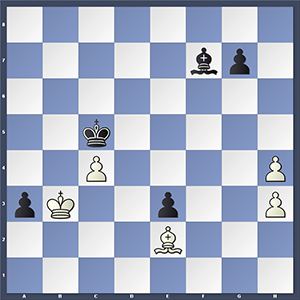
Anish Giri chose the Scotch in his game against Dmitry Andreikin. The early novelty of 8…Nge7 produced rapid development for both sides. White had a little more space, expanding quickly on the Queenside to where Black had a nice bishop on the g1-a7 diagonal, aiming right at White’s King. This was quickly liquidated and the other minor pieces soon followed. The resulting position saw both players with risky King positions, due to the g-file being open, whether either of them could use this to their advantage was the issue at hand. White was always in control of the position, first due to a passed b-pawn that needed dealing with and then when his Queen obtained a good position on the f6-square, Black erred very badly. 36…Rb8 was a serious mistake that handed a very powerful opportunity to White, with 37.e5!
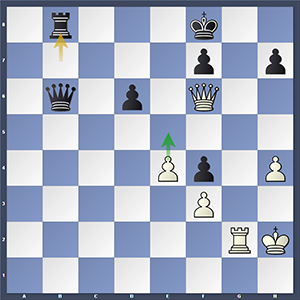
Or would have, but Giri missed it. It has to be said, that the Dutchman was short on time and had the clock situation been slightly better, I have no doubt that he would have found this move. The point about e5, is that it gives White powerful access to the Black King. Should Black take the pawn, with 37…dxe5, then White has 38.Qh8+ which forces the King onto the e-file. After this, White can recapture on e5 with check and the Black King has nowhere to hide from the attack with the open files at White’s disposal. Not only this, but Black’s pawns are all isolated and there for the picking, which is what would happen should Black not take on e5: 37…Qd4 (for example) 38.Qg7+ Ke8 39.Qg8+ Ke7 40.exd6+ Qxd6 41.Re2+ Kd7 with Qxf7 to follow. Unfortunately for Giri, his own move of 37.Rd2 was less potent and after Black’s wise 37…Re8, there was nothing left and the game ended in a draw soon after.
Richard Rapport was in no mood to be photographed at the start of this round, and after his disappointment in the previous round (where he should have defeated Wesley So but ended up losing) this is totally understandable. How would he fair in this round against Radoslaw Wojtaszek? The game was a Sicilian Dragon in which 9.Nd5 seems to be a novelty. It did not really do White any favours, however, Black managed to equalise without too much trouble and soon ended up better, his rooks mobilised and doubled along the e-file. White’s rooks occupied the d-file, but found themselves muted, mainly by their own pawn. When Black’s Knight found a good square on e4, White began to look quite restricted. However, on the other hand, Black had no more potential and sooner or later White would be playing f3 in order to boot the Ne4 out.
Thus Black turned his attention to the Queenside, switching his rooks to the b-file in order to support an intended b5-b4 advance. When this happened, White took it in his stride and the position was about level. 41…Nf6 was not the best move by Black, it was a little backward and out of context and should really have given way to the more appropriate …Qc2. White seized the initiative with 42.Rc1 and 43.Bb5 which shut Black’s b-pawn away from its protectors and left it hanging. All of a sudden, it was White with the initiative. There followed 43…Re7 44.Qd2 b3 and here, White should maybe have taken a moment to tidy up and play 45.f3, removing the e4-square from Black’s knight. Instead, Rapport went for 45.Rd3 and after …Ne4 46.Qe3 Nc5 Black had things covered. The result was a draw in 52.
Aronian-Nepomniachtchi: Nepomniatchi familiar with the position, had it before against So in Dortmund 2015 and against Sanikidze at this year’s Eurasian Blitz Chess Cup. In each case he had continued with 10…h5 and this had brought him mixed success — a loss against So and a win against Sanikidze. Against Aronian, he deviated with 10…Nbd7 and the game followed Filgueira-Garcia from Buenos Aires 1995. That was until Nepomniachtchi varied again with 15…f5 (…Nf6 had been played in the previous game, for a rather quick draw).
Van Wely-So: English Opening, 9.cxd5 a novelty. Black managed to equalise fairly comfortably, exchanging Queens early on. White obtained the bishop pair — would this be relevant later on? Perhaps Van Wely was hoping for a nice safe position after his ‘gamus-horribialis’ in the previous round?
Ian Nepomniachtchi took up the Modern Benoni in response to Levon Aronian’s 1.d4. The game followed Filgueira-Garcia, Buenos Aires 1995, until Black’s 15…b5 (…Nf6 was played in the previous game, which was drawn). It did not really produce a game of any event and the players repeated after a little bit of exploration and split the point. Harikrishna-Karjakin was a Giuoco Piano which left theory on Black’s 14…Bxb3. Further exchanges happened rather quickly, leaving a rook ending that neither could really be bothered with and they shook hands on move 30. The game was quite boring as Pentala said himself on Twitter.

All of this leaves Pavel Eljanov leading the Tata Steel Masters at the first rest day. The Ukrainian Grandmaster has a near perfect 3.5/4 score. However, So and Carlsen are hot on his heels, just a half point behind. Wednesday is a rest day, with play resuming on Thursday. This will take place at the stadium of Dutch football team, Feyenoord as part of the tournament’s ‘Chess On Tour’ initiative. The games will start a little later, at 14:00 local time.
Masters Group Standings after Round 4.
- Eljanov — 3.5
- Carlsen, So — 3.0
- Harikrishna, Karjakin — 2.5
- Giri, Andreikin, Aronian, Wei — 2.0
- Nepomniachtchi, Wojtaszek — 1.5
- Rapport, Adhiban — 1.0
- Van Wely — 0.5
Masters Group Round 5, Thursday 19th January, 14:00 local time.
Eljanov – Aronian
Karjakin – Adhiban
So – Harikrishna
Wojtaszek – Van Wely
Andreikin – Rapport
Wei – Giri
Nepomniachtchi – Carlsen.
In the Tata Steel Challengers, every game was decisive! Markus Ragger is leading the group with a perfect 100% score. On the way to this score, he had already chalked up wins against Jeffery Xiong, Tingjie Lei, and Eric Hansen.
In round 4 he defeated Vladimir Dobrov in a symmetrical English. Black was equal very quickly, and some overly aggressive play by White allowed his opponent to seize the upper hand. When Black’s rook took control of White’s second rank, there was nothing that could be done to prevent the Queen from joining it and mate would soon have followed, the Russian resigned.
Other winners in round four, were Shanglei Lu, who defeated Benjamin Bok in a very aggressively played Sicilian Najdorf. Bok will be disappointed with the game as he was substantially better at one point and possibly on the verge of winning. Unfortunately for him, his 33…Rc8 undid all of his hard work in one fell swoop. Lu didn’t look back from here.
Bok’s countryman, Jorden van Foreest, took to the Taimanov Sicilian against Eric Hansen of Canada. Van Foreest was playing catch-up for the whole game really, Hansen was in full control and Black was quite crushed in the end.
Nils Grandelius didn’t have the best of times against Jeffery Xiong, who answered 1.e4 with 1…d5 — fancy playing the Scandinavian against a Swede! It very nearly backfired on the American, however, as White got a very nice position from it. Had Grandelius gone for 17.hxg6(!) the result could have been very different. As it was, White sought too many complications, which included sacrificing the exchange of rook for knight. This was unnecessary and costly. It allowed Black important time to sought out his position and gain activity after which White’s position lost its bite and he was simply an exchange down. Black later gave the exchange back, but with White having to stop a back rank mate, at the same time as having his knight en-prise, there was nothing left but to resign.
Erwin l’Ami gave the Dutch fans something to cheer about by taking a point in this round. Good grief, though, he did his very best not to! He chose the Modern Benoni against Tingjie Lei and it produced all kinds of craziness. It was a bit of a scrappy game, full of complications and in the end White found herself completely overwhelmed by Black’s Queenside pawns and resigned.
Black equalised very rapidly in Guramishvili-Smirin and was soon very much better. However, thanks to good defence from White and a missed chance or two by Black, things equalised. Sopiko, having obtained two very nice advanced passed pawns, will be very disappointed with her 39.a6(? Kf3!) which allowed Black to pick up a pawn while hampering White’s King activity at the same time. While White was unable to get her King to her pawns in time to help them Queen, Black found himself with the luxury of two passers himself, and with White unable to cover both of them this proved terminal.
Gawain Jones outplayed his opponent, Aryan Tari in a very tense endgame, in which the activity of White’s rooks and King decided the day.
Challengers Group Standings after Round 4.
- Ragger — 4.0
- Smirin — 3.5
- Xiong, Lu, Jones — 2.5
- Dobrov, l’Ami, Grandelius, Hansen — 2.0
- Bok — 1.5
- van Foreest, Tari, Lei — 1.0
- Guramishvili — 0.5
Challengers Group Round 5, Thursday 19th January, 13:30 local time.
Smirin – Grandelius
Tari – Guramishvili
Bok – Jones
Ragger – Lu
van Foreest – Dobrov
l’Ami – Hansen
Xiong – Tingjie.
